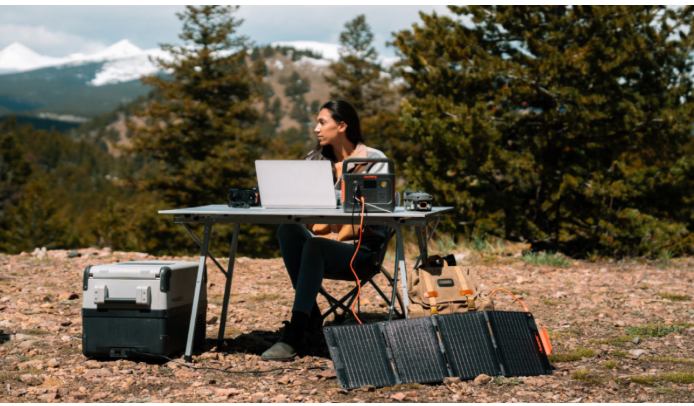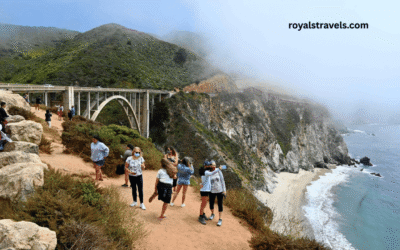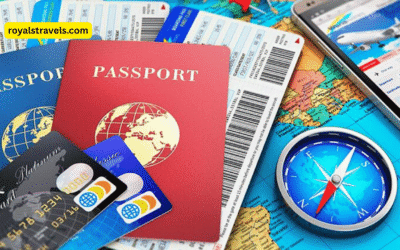Aerial drone photography, with its unique bird’s-eye view, brings unprecedented visual appeal to travel documentation and video production. It can capture expansive scenes that traditional shooting methods cannot achieve, whether it’s majestic mountains and seas or the intricate layout of urban architecture, all can be presented with stunning effects through aerial photography.
To get beautiful results, you need more than just a drone. The right skills help you avoid poor angles, shaky shots, and basic mistakes. Good flying also means following the rules.
This blog will talk about 10 important aerial drone photography skills you may need, common issues to address, such as solar power stations for backup power, and how to start practicing. Read on to learn more.
10 Aerial Drone Photography Techniques
Aerial drone photography allows you to capture powerful images from above, but to do it well, you need more than basic flying. Good planning, timing, and trustworthy power are all part of the process.
The best aerial drone photography techniques are:
-
Understand Drone Regulations
Flying a drone may seem simple at first, but without understanding the laws, you can face fines or even lose your equipment. Different countries and regions have clear regulations on drone flight altitude, no-fly zones, registration requirements, and other aspects.
The Federal Aviation Administration (FAA) department handles all drone rules in the United States. For example, if your drone weighs more than 250 grams, you will be required to register it. You should always fly below 400 feet, keep the drone in sight, and avoid airports. For business use, a Part 107 license is required. [1]
-
Practice Flight Control First
To take great aerial photos, you first need to feel confident with the controls. Flying a drone takes practice, especially if you want smooth and steady shots.
Start in a quiet, open space and spend time learning how your drone moves. Try slow turns, gentle rises, and steady landings. It also requires stable control under different wind speeds, as well as learning to monitor key parameters such as battery level and GPS signal to ensure flight safety.
The more you practice, the more natural it will feel. This way, when it’s time to take real shots, you can focus on the view instead of worrying about the controls.
-
Repeatedly Practice Shooting Routes
Aerial drone photography gets better when you take time to plan and fly the same route more than once. It helps you figure out the best spots, angles, and timing for your shots.
Try flying slowly and adjusting your path each time to maintain control. This will make your movements more natural and improve the quality of your photos. Repeating routes also makes you more confident and ready for different locations.
-
Pay Attention to Downwind Shooting
In aerial photography with drones, wind can change the way your shots turn out. When flying downwind, the drone moves faster than normal, and this can make your video or photos look rough or uneven if you can’t control your drone well.
To manage this, fly in a straight path and reduce your speed. Avoid quick changes in direction. Always check wind direction before flying so you can plan your shots better. Staying aware of wind flow makes your footage look more natural and clean.
-
Start with Auto Shooting Mode Before Switching to Pro Mode
When you are new to aerial drone photography, it is better to start with auto shooting mode. This setting handles light, focus, and color on its own, so you can focus more on flying and framing your shots.
Once you feel more confident, you can slowly try pro mode to adjust things like ISO, shutter speed, and white balance. Switching too early can make things confusing, especially if you are still learning. If you start simple, you will be able to actually enjoy the process and understand what works best in different scenes.
-
Save Images in Raw Format
In aerial drone photography, saving images in RAW format gives you more control during editing. RAW files keep more detail than JPG, which helps when adjusting light, color, or shadows later.
The file size stays bigger, but the quality is high even after editing. This is useful when you want to make your photos look clear and sharp without losing important parts of the image. You can turn on RAW format in your drone settings before starting your shoot.
-
Shooting Techniques
Using different shooting techniques can make your aerial drone photography more eye-catching. These methods help you tell a better story through your shots and bring out the beauty of the scene.
- Hovering in place. It means keeping the drone still in the air to focus clearly on one subject. Stable hovering is easier in environments with strong GPS signals and no wind.
- Circle shots make the drone fly around the subject, giving a smooth view from all sides. Maintain an appropriate flight radius to avoid image tilt from centrifugal force or collisions with obstacles.
- Follow shots keep a moving person or object in the frame as the drone follows it. However, beginners should be caution in complex environments, such as forests or clusters of buildings.
- Dolly zoom is done by flying the drone backward while zooming in or descending vertically from a high altitude, which creates a cool, stretched look.
- Backlight shooting works well during sunrise or sunset, when the light shines behind the subject, creating an artistic effect.
- Foreground elements like trees or flowers in front of the camera add depth to your photo.
- Panoramic shooting captures a wide view by taking several pictures and joining them together.
-
Composition Principles
Composition helps make your aerial drone photography clearer and pleasing to look at.
- One simple way is the rule of thirds, where you divide the image into three parts and place your main subject near the side or at the intersection, not in the middle. This gives a more natural feel to the photo.
- You can also use leading lines, like natural places, including roads, rivers, or fences, to draw attention to your subject.
- Symmetry and contrast are useful too. A balanced view or a mix of light and dark areas can make your photo more striking.
-
Lighting and Timing Selection
Lighting and timing can change the whole look of your aerial drone photography. The best times to shoot are usually during sunrise or sunset, when the light is soft and the sky has warm colors.
Cloudy or foggy days can add a calm and dreamy effect to your shots, while night shooting gives a chance to capture city lights or quiet streets from above. However, these environments require waterproof drones, and flight should be avoided in low visibility conditions.
Each time of day brings a different mood, so try shooting at different hours to see what works best for your style.
-
Post-Processing and Optimization
Post-processing is the final step that can improve the look of your aerial drone photography. After taking the photos, you can use editing tools to adjust brightness, color, and sharpness.
You can make the sky look clearer, fix dull colors, or correct areas that look too dark or too bright. It doesn’t need to change the photo fully, but to make it look more natural and clean. With a few simple edits, your photos can look ready to share or use in any project.

How to Solve Common Drone Photography Issues?
Aerial drone photography can come with a few common problems that may spoil your shots. Things like blurry images, weak signals, or lighting issues can happen anytime. It is extremely important to know how to handle these so you can keep your work stress-free. Here are some easy ways to fix them.
-
Image Jitter
If your photos or videos appear shaky, you may be facing image jitter. This usually happens when the gimbal is not set correctly, propeller damage, or the wind is too strong.
You can fix this by calibrating the gimbal and checking the propeller before each flight. Try not to fly in extreme windy weather, as it will make it quite difficult to keep the drone stable. Once you have the proper setup and are sure of the calm conditions, your images will come out much clearer.
-
Signal Loss
Signal loss is a common issue in aerial drone photography, especially in areas with tall buildings, trees, or weak GPS. Losing connection can lead to panic or even drone crashes.
To avoid this, always check and set the return-to-home feature before flying. This will make sure your drone comes back safely if the signal drops. Then, adjust the remote control antenna to be parallel to the drone’s direction, not pointing directly at it.
-
Insufficient Battery Life
Insufficient battery life is a common problem, especially during long shoots or in cold weather. It can cause your drone to land early or miss important shots.
-
Battery Life Estimation
Battery life in aerial drone photography is limited and must be watched closely. Most camera drones give a flight time of 25 to 30 minutes at best or a maximum of 2 hours, and this is only under perfect conditions, like no wind.
This means you should plan to land when the battery reaches around 20 to 25 percent. Waiting longer can risk sudden drops or emergency landings.
-
Preparing Backup Power Sources
Charging a drone battery is important for long shooting days. Backup power sources help you continue your work and avoid waste time.
How to charge a drone battery outdoor? Solar portable generators are an eco-friendly option. They can charge your drone batteries in outdoor locations without finding a socket. For example:
-
Jackery Solar Generator 240 v2
The Jackery Solar Generator 240 v2 is a small and lightweight power generator made for outdoor use like drone shoots, travel, or camping. It has a strong battery and charges fast, so you can use it even in remote places.
Key Features
- 256Wh LiFePO4 battery with up to 10-year lifespan
- 3.3-hour full charging through one Jackery SolarSaga 100W solar panel
- Dual USB-C and one USB-A ports support fast charging for multiple shooting devices simultaneously
- The Jackery Explorer 240 v2 Portable Power Station weighs only 7.7 lbs, easy to carry with a folding handle
-
Jackery Solar Generator 1000 v2
The Jackery Solar Generator 1000 v2 is a larger backup power option for both home and outdoor use. It charges quickly, runs quietly, and is durable in various environments, making it useful during aerial drone photography or power cuts.
Key Features
- 1070Wh capacity with 1500W output for essential appliances
- Offer USB-A/C ports, support up to 100W dual PD charging
- Full recharge in 3.8 hours with two Jackery SolarSaga 200W solar panels
- Serve as UPS with≤20ms switching for device stability
Start Practicing Your Aerial Photography Skills!
To get better at drone photography, the best thing you can do is practice. The more you fly, the more confident you become. When you try different places and scenes, you will always find something new to capture.
-
Natural Landscapes
One of the easiest and most beautiful places to begin is nature. Fly your drone over hills, rivers, beaches, or forests. These wide areas give you lots of space and fewer obstacles. You can capture the calm of a lake or the movement of waves. Sunrise or sunset makes these scenes look magical from the sky.
-
Urban Architecture
If you’re near a city, try capturing streets and buildings from above. From a higher angle, cities look completely different. Roads, cars, and rooftops form interesting patterns. You can also film crowds, parks, or public spaces. Just try to be careful and follow any local drone rules in busy areas.
-
Event Documentation
Shooting events are a fun way to improve your skills. Weddings, sports, parties, outdoor adventures, or even a picnic can look amazing from above. You will learn how to follow movement, focus on people, enjoy taking photos, and click shots that feel lively and real. It’s a great way to turn memories into something special.
Conclusion
Aerial drone photography improves with practicing these skills, and each flight teaches you something new. Shooting nature, city views, or special events becomes easier when your drone stays charged.
Jackery portable generators help photographers work in outdoor or remote places. They are light, simple to use, and give enough charge for your tools. Stay ready to fly, film, and capture great shots through aerial drone photography. Get your backup power source now and take your photography to the next level!
References
[1] Federal Drone Laws in the United States. Available at: https://pilotinstitute.com/drones/ (Accessed: 14 August 2025)



0 Comments